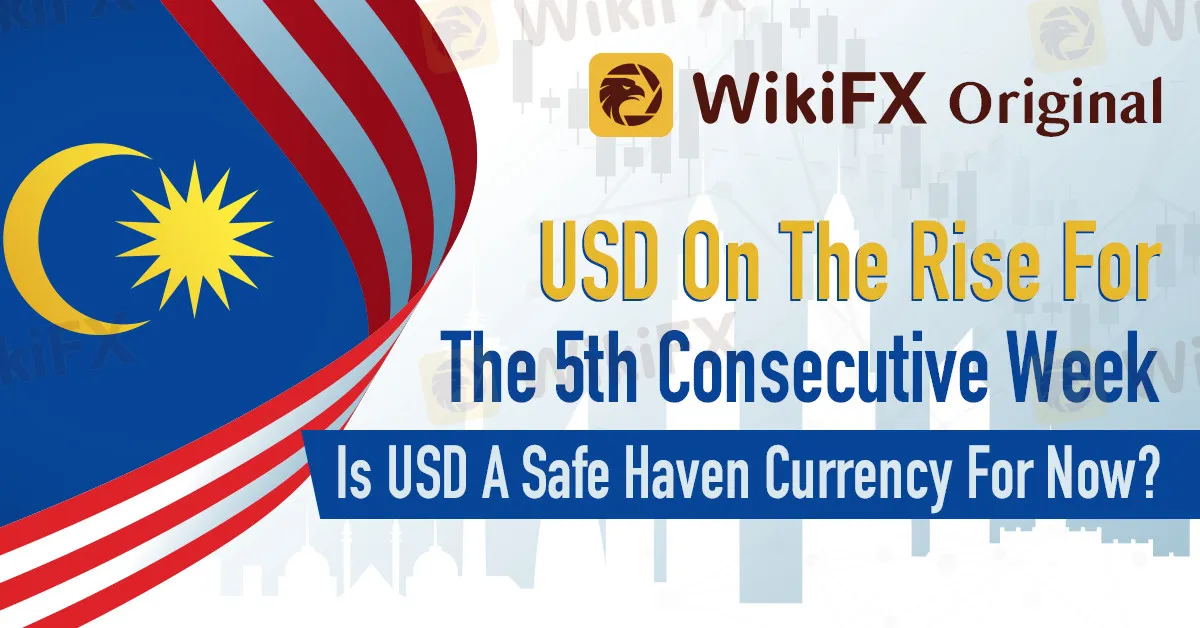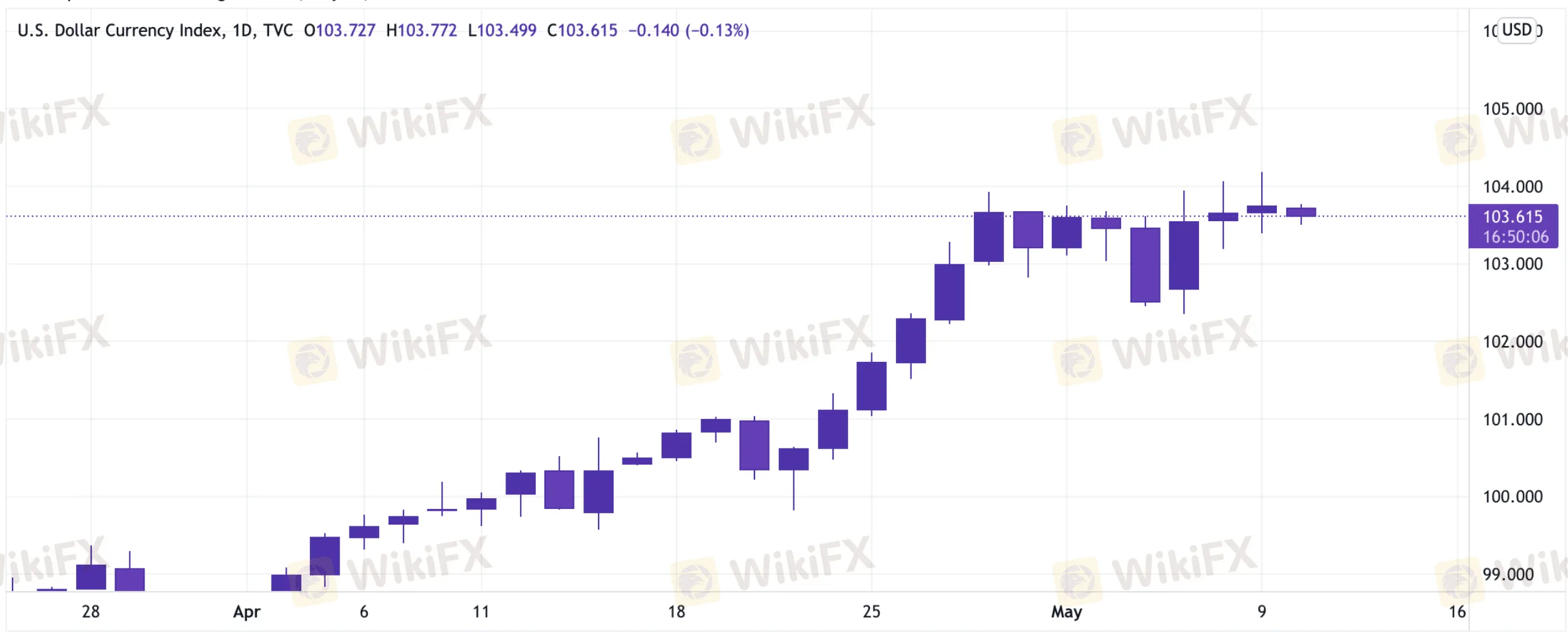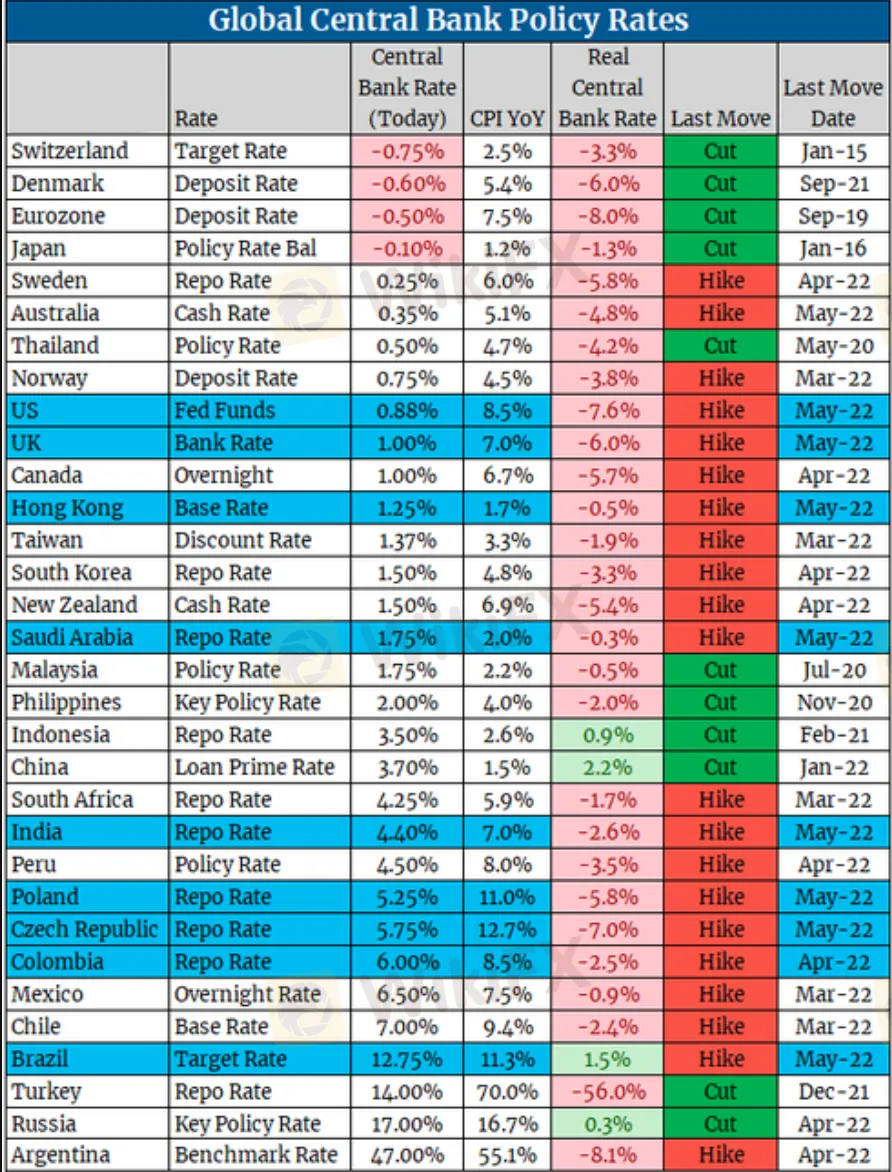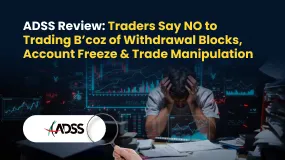简体中文
繁體中文
English
Pусский
日本語
ภาษาไทย
Tiếng Việt
Bahasa Indonesia
Español
हिन्दी
Filippiiniläinen
Français
Deutsch
Português
Türkçe
한국어
العربية
USD On The Rise For The 5th Consecutive Week | Is USD A Safe Haven Currency For Now?
Abstract:The U.S. dollar is up for the fifth consecutive week as traders brace themselves for the upcoming CPI and PPI reports. The rise of USD could be continue in the foreseeable future and could cause disruptions especially in the emerging markets.

<WikiFX Malaysia Original – Editor: Fion>
On Monday (May 9), the U.S. dollar index hit a 20-year high of 104.1921, stemming in part from concerns about the Federal Reserve‘s ability to fight high inflation, sparking risk aversion and boosting the dollar’s safe-haven appeal. As of writing, the USD is trading at 103.615 and this marks the fifth consecutive week of its rally as the U.S. Treasury yields climb.

Samy Chaar, the chief economist at Lombard Odier, said the dollar's surge has the potential to “disrupt the broader market environment and expose economic and financial vulnerabilities in the existing financial system.”
The dollar index has gained about 8% year-to-date. Although many analysts argue that the dollar has reached its peak, this current uptrend seems difficult to reverse as the dollar‘s safe-haven appeal remains intact. Barclays’ dollar financing stress indicator is approaching its highest level in 7 years and Barclays range analysis reports a possibility for the dollar index to rise another 2-3%.
As the dollar strengthens, developing countries must tighten monetary policy to prevent their currencies from depreciating. Failure to do so will increase inflation and push up the cost of servicing dollar-denominated debts. In just a few days since the start of May, several central banks from emerging economies have raised their interest rates accordingly too.

Generally, in foreign exchange and commodity markets, a stronger dollar makes dollar-denominated commodities more expensive, consequently dampening consumer demand and thus prices. However, that has not happened this year due to existing supply chain challenges such as Russia-Ukraine conflict and global epidemic blockade that have hampered production and trading of major commodities which have been driving prices up.
On the contrary, the Fed is more than happy to see the dollar rise even higher at the moment. Société Générale S.A. expects that every 10% appreciation of the dollar could lead to a 0.5 percentage point drop in the U.S. CPI. Therefore, the Fed may also raise interest rates by 200 basis points, while the Fed's policy rate could reach a peak of approximately 3.5% by mid-2023.
Federal Reserve Bank of Minneapolis President, Neel Kashkari explained on Friday that suppose if supply chain issues continue to persist, the Fed ought to be more aggressive in raising interest rates while facing the risk of recession. However, he also mentioned that this approach alone is unlikely to be the core solution to bring inflation down to the Feds 2% target. He reiterated that policymakers should pay close attention to the degree of interest rate rise to maintain a healthy equilibrium.
The U.S. will be releasing the Consumer Price Index (CPI) and Producer Price Index reports on both May 11 and 12 (UTC +8) respectively.


According to the survey carried out by Reuters, economists are expecting to see the median estimate of prices rise at an annual rate of 8.1% in April. It is time for dollar traders and investors to fasten their seatbelts once again in preparation for a volatile ride.
<WikiFX Malaysia Original – Editor: Fion>

Disclaimer:
The views in this article only represent the author's personal views, and do not constitute investment advice on this platform. This platform does not guarantee the accuracy, completeness and timeliness of the information in the article, and will not be liable for any loss caused by the use of or reliance on the information in the article.
Read more

Grand Capital Doesn’t Feel GRAND for Traders with Withdrawal Denials & Long Processing Times
The trading environment does not seem that rosy for traders at Grand Capital, a Seychelles-based forex broker. Traders’ requests for withdrawals are alleged to be in the review process for months, making them frustrated and helpless. Despite meeting the guidelines, traders find it hard to withdraw funds, as suggested by their complaints online. What’s also troubling traders are long processing times concerning Grand Capital withdrawals. In this Grand Capital review segment, we have shared some complaints for you to look at. Read on!

ADSS Review: Traders Say NO to Trading B’coz of Withdrawal Blocks, Account Freeze & Trade Issues
Does ADSS give you plenty of excuses to deny you access to withdrawals? Is your withdrawal request pending for months or years? Do you witness account freezes from the United Arab Emirates-based forex broker? Do you struggle to open and close your forex positions on the ADSS app? Does the customer support service fail to respond to your trading queries? All these issues have become a rage online. In this ADSS Broker review article, we have highlighted actual trader wordings on these issues. Keep reading!

INGOT Brokers Regulation 2025: ASIC vs Offshore License - What Traders Must Know
Explore INGOT Brokers regulation in 2025: Compare their ASIC and Seychelles FSA licenses, understand trader protection levels, and learn about potential risks in this detailed guide.

INGOT Brokers Review 2025: High Risk or Hidden Gem? Expert Analysis Reveals All
Comprehensive INGOT Brokers review exploring the broker's mixed reputation in 2025. Discover the truth about regulation, trading options, and user experiences before opening an account.
WikiFX Broker
Latest News
Consob Targets Political Deepfake “Clone Sites” and Unlicensed Platforms in Latest Enforcement Round
WikiEXPO Global Expert Interviews: Gustavo Antonio Montero: ESG in Finance
2 Malaysians Arrested in $1 Million Gold Scam Impersonating Singapore Officials
Is FXPesa Regulated? Real User Reviews & Regulation Check
Fraud Mastermind Zhimin Qian Sentenced to 11 Years for $6.6 Billion Bitcoin Ponzi Scheme
Almahfaza Broker – 2025 Review: Safe or Scam?
Uniglobe Markets Review 2025: A Complete Guide to an Unregulated Broker
INZO Broker No Deposit Bonus: A 2025 Deep Dive into Its Offers and Risks
Exness Broker Expands in South Africa with Cape Town Hub
Global Guide to Finding Forex IBs/Brokers — Share Your Pick and Win Big!
Currency Calculator



